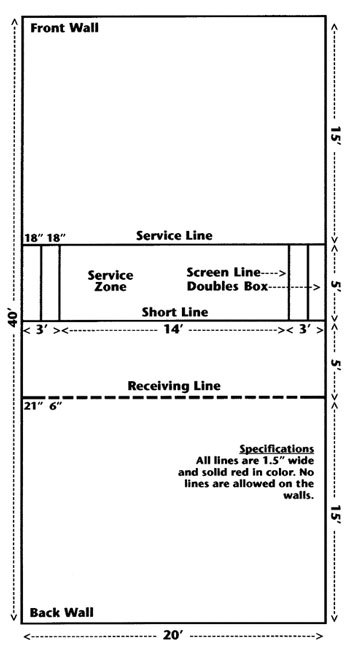Racquetball Court Rules

Let’s talk about the rules surrounding the racquetball court itself and all those mysterious line. Officially, racquetball court dimensions are 20 feet wide by 20 feet high and 40 feet long. The lines that mark different zones on the court need to be at least 1 ½ inches wide for proper visibility.
All flat surfaces of the court are considered in-play, but anything that sticks out and can unexpectedly change the trajectory of a ball can be designated as out-of-play and result in court hinders. Things like door handles or light fixtures that don’t align snugly with the rest of the wall or anything of that nature. So accidentally hitting any of them results in a court hinder, which means that the rally is simply replayed.The same rule can apply if a ball hits a wet spot (due to sweat). The rally is usually stopped, the court cleaned, and the rally gets replayed.
The service line is the line closest to the front wall and marks one of the edges of the service zone. The significance of this line is that during a serve the server may not completely step beyond this line without having at least some part of both feet being either on the line or inside the service box. Doing that results in a foot fault and the serve is automatically lost.
The short line is the line that is in the middle of the court, 20 feet from the both the back and front wall. It marks the other edge of the service zone. The significance of this line is that during a serve, after the ball rebounds off the front wall, it must completely pass the short line before hitting the floor. If the ball hits the floor before or on the short line, the serve is considered a short serve and it is a fault.
This line is also important during the beginning of the serve. It is illegal to extend your foot beyond the short line during the beginning motion of the serve and it results in a fault serve. The server also must remain in the service box until the ball passes the short line after hitting the front the wall and only at that moment can the server step over the short line.
The two small rectangular boxes on each side of the service zone closest to the side walls are called the service boxes. They are only in use during doubles and simply indicate where a player on the serving team who is not currently serving can stand during serves. That player can chose either of the boxes, depending on the strategy of the team.
The next two short lines that are parallel to the side walls and are within the service zone are called drive serve lines. These lines are at least 3 feet away from each side wall and they mark the drive serve zone. When doing a down-the-line drive serve, it is illegal for any part of the body or the racquet to pass over the drive serve lines and results in a fault serve. This rule doesn’t apply to lob, half-lob, cross-court, or Z serves.
Finally, the last dashed line on the racquetball court is called the receiving line (or encroachment line) and together with the short line they outline the safety zone. It is illegal for the receiver to pass the receiving line either with the body or the racquet until the ball either bounces inside the safety zone or passes the receiving line in the air. A violation of this rule results in a point awarded to the server. This is the rule that makes lob serves so effective and prevents the receiver from immediately attacking them.
Here’s a very in-depth video where Johnny Boyd explains everything there is to know about all the court markings:
If you still have a question about something that wasn’t covered in this article, you should be able to find the answer by going over the official USAR rules.
